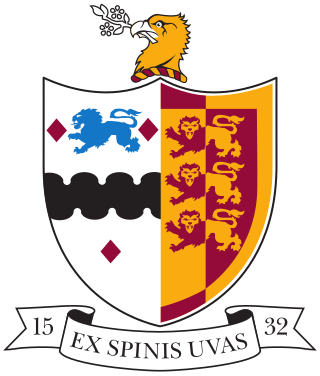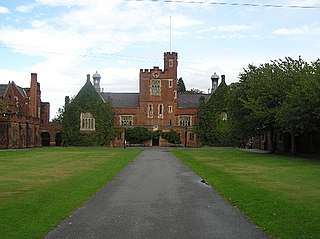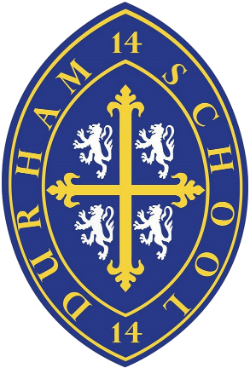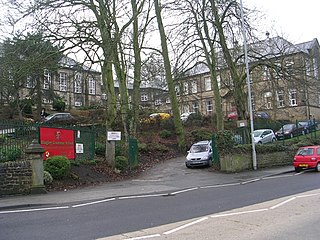
Haberdashers' Adams Grammar School is a selective grammar school for high-achieving boys aged 11-18 and girls aged 16-18 with state boarding for boys only, located in Newport, Shropshire, offering day and boarding education. Current (2021) boarding fees are £12,144 per year and £13,644 per year for overseas students It was founded in 1656 by William Adams, a wealthy member of the Worshipful Company of Haberdashers. In January 2018, the school changed its name to Haberdashers’ Adams, replacing the previous name, Adams' Grammar School (AGS). The school is commonly referred to as Adams Grammar. From 2024, the school will go fully co-ed admitting girls into Year 7.

Bristol Grammar School (BGS) is a 4–18 mixed, private day school in Bristol, England. It was founded in 1532 by Royal Charter for the teaching of 'good manners and literature', endowed by wealthy Bristol merchants Robert and Nicholas Thorne. The school flourished in the early 20th century under headmaster Sir Cyril Norwood (1906–1916), embodying "the ideals and experiences of a leading public school". Norwood went on to serve as the master at Marlborough College and Harrow, and as president of St John's College, Oxford.

Loughborough Grammar School is a 10–18 independent boys school in the town of Loughborough, Leicestershire, England, founded in 1495 by Thomas Burton. Today, roughly one in ten boys at the school are boarders, with the remainder being day students. It is one of four schools known as the Loughborough Schools Foundation, along with Loughborough High School, Fairfield Preparatory School and Loughborough Amherst School.

Reigate Grammar School is a 2–18 mixed private day school in Reigate, Surrey, England. It was established in 1675 by Henry Smith.

The Royal Grammar School (RGS), Newcastle upon Tyne, is a selective British private day school for pupils aged between 7 and 18 years. Founded in 1525 by Thomas Horsley, the Mayor of Newcastle upon Tyne, it received royal foundation by Queen Elizabeth I and is the city's oldest institution of learning. It is one of seven schools in the United Kingdom to bear the name "Royal Grammar School", of which two others are part of the independent sector.

Oakham School is a public school in Oakham, Rutland, England.
Ripon Grammar School is a co-educational, boarding and day, selective grammar school in Ripon, North Yorkshire, England. It has been named top-performing state school in the north for ten years running by The Sunday Times. It is one of the best-performing schools in the North of England; in 2011, 91% of pupils gained the equivalent of 5 or more GCSEs at grade C or above, including English and maths; the figure has been over 84% consistently since at least 2006. As a state school, it does not charge fees for pupils to attend, but they must pass an entrance test at 11+ or 13+. There is no selection test for entry into sixth form as pupils are admitted on the basis of their GCSE grades.

The Skinners' School, is a British Grammar School with academy status for boys located in the town of Royal Tunbridge Wells, Kent, England. Established in 1887, the school was founded by the Worshipful Company of Skinners in response to a demand for education in the region. Today Skinners' remains an all-boys grammar school, recently awarded specialist status in science and mathematics in recognition of these disciplines' excellent teaching. The current enrolment is 1119 pupils, of whom around 326 are in the sixth form. The first headmaster was Reverend Frederick Knott, after whom Knott House is named. The current Headmaster is Edward Wesson.
The Hinckley School is a coeducational secondary school located in Hinckley, Leicestershire, England. The school also includes the John Cleveland Sixth Form Centre.
Bethany School is a private boarding and day school for girls and boys aged 11–18, in Goudhurst, Kent, United Kingdom.

Durham School is a fee-charging boarding and day school in the English public school tradition located in Durham, North East England. Since 2021 it has been part of the Durham Cathedral Schools Foundation.

The Crossley Heath School is an 11–18 mixed, grammar school and sixth form with academy status in Halifax, West Yorkshire, England. It was established in 1985 following the amalgamation of Heath Grammar School and Crossley and Porter School. It is part of The Crossley Heath School Academy Trust Limited.

Hutton Grammar School is an 11–18 boys voluntary aided, state-funded Church of England comprehensive day school. It is located 3 miles (4.8 km) south west of Preston, Lancashire, in Hutton, England. It provides education for boys from the age of 11 to 16, and in the Sixth Form for both boys and girls.

The Robert Smyth Academy is a secondary school in Market Harborough, Leicestershire, England, for 11- to 19-year-olds. It is situated in the north of the town, on Burnmill Road, close to St Luke's Hospital.

Barnard Castle School is a co-educational private day and boarding school in the market town of Barnard Castle, County Durham, in the North East of England. It is a member of The Headmasters' and Headmistresses' Conference (HMC). It was founded in 1883 with funding from a 13th-century endowment of John I de Balliol and the bequest of the local industrialist Benjamin Flounders. The ambition was to create a school of the quality of the ancient public schools at a more reasonable cost, whilst accepting pupils regardless of their faith.

Bacup and Rawtenstall Grammar School (BRGS) is a selective co-educational academy grammar school in Waterfoot, Rossendale, Lancashire, England. The school is named after the two main towns either side of Waterfoot, Bacup and Rawtenstall.

Bingley Grammar School (BGS) is a Voluntary aided school for students from the ages of 11–18 and is located on the outskirts of Bingley, West Yorkshire, England.

Kings Priory School is a mixed all-through school and sixth form located in Tynemouth, Tyne and Wear, England. The current principal is Mr Philip Sanderson. The school has a Christian foundation as the largest member of the Woodard Corporation, but accepts pupils of any religious background. It is located immediately to the east of Tynemouth Metro Station

Larne Grammar School is a co-educational voluntary grammar school located in Larne, County Antrim, Northern Ireland. Founded in 1886 by Sir Edward Coey and John Crawford, it has around 760 pupils and 50 teaching staff.

Limavady Grammar School is a co-educational 11-18 selective grammar school in Limavady, County Londonderry in Northern Ireland. Situated on the Ballyquin Road, it is close to other schools in the town, including Limavady High School and St. Mary's High School. In 2008, the school was placed 139th in The Times school league table for the UK, which is based on both GCSE and A-level results.

















